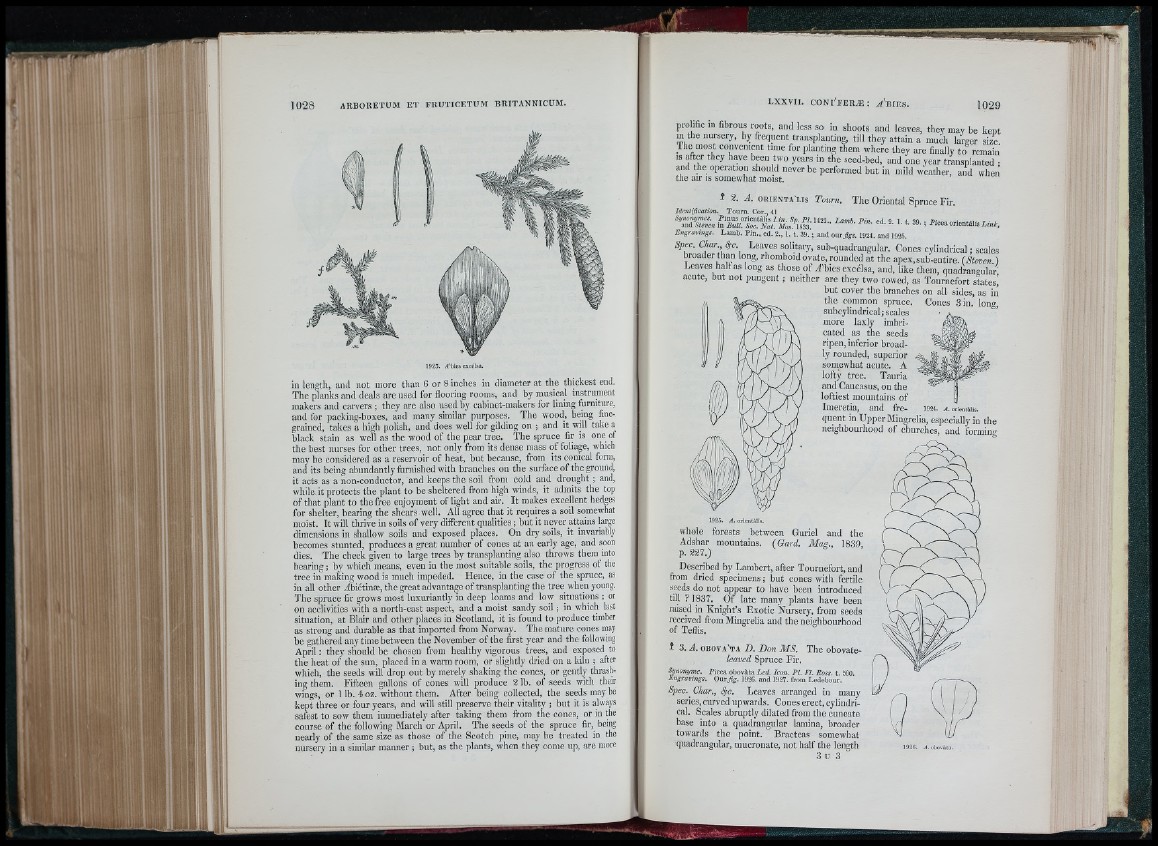
1923. ^ 'b ie s « c é ls a .
in length, and not more than 6 or 8 inches in diameter at the thickest end.
The planks and deals are used for flooring rooms, and by musical instrument
makers and carvers ; they are also used by cabinet-makers for lining furniture,
and for packing-boxes, and many similar purposes. The wood, being finegrained,
takes a high polish, and does well for gilding on ; and it will take a
black stain as well as the wood of the pear tree. The spruce fir is one of
the best nurses for other trees, not only from its dense mass of foliage, which
may be considered as a reservoir of heat, but because, from its conical form,
and its being abundantly furnished with branches on the surface of the ground,
it acts as a non-conductor, and keeps the soil from cold and drought ; and,
while it protects the plant to be sheltered from high winds, it admits the top
ofthat plant to the free enjoyment of light and air. It makes excellent hedges
for shelter, bearing the shears well. All agree that it requires a soil somewhat
moist. It will thrive in soils of very different qualities ; but it never attains large
dimensions in shallow soils and exposed places. On dry soils, it invariably
becomes stunted, produces a great number of cones at an early age, and soon
dies. The check given to large trees by transplanting also throws them into
bearing; by which means, even in the most suitable soils, the progress of the
tree in making wood is much impeded. Hence, in the case of the spruce, as
in all other AbictinEe, the great advantage of transplanting the tree when young.
The spruce fir grows most luxuriantly in deep loams and low situations ; or
on acclivities with a north-east aspect, and a moist sandy soil; in which last
situation, at Blair and other places in Scotland, it is found to produce timber
as strong and durable as that imported from Norway. The mature cones rnay
be gathered any time between the November of the first year and the following
April: they should be chosen from healthy vigorous trees, and exposed to
the heat of the sun, placed in a warm room, or slightly dried on a kiln ; after
which, the seeds will drop out by merely shaking the cones, or gently thrashing
them. Fifteen gallons of cones will produce 2 lb. of seeds with their
wings, or 1 Ib. 4 oz. without them. After being collected, the seeds may be
kept three or four years, and will still preserve their vitality ; but it is always
safest to sow them immediately after taking them from the cones, or in tbe
course of the following March or April. The seeds of the spruce fir, being
nearly of the same size as those of the Scotch pine, may be treated in the
nursery in a similar manner ; but, as the plants, when they come up, are more
pro ific m fibrous roots, and less so in shoots and leaves, they may be kept
in the nursery, by frequent transplanting, till they attain a much larger size
The most convenient time for planting them where they are finally to remain
18 after they have been two years in the seed-bed, and one year transplanted ■
and the operation should never be performed but in mild weather, and when
the air is somewhat moist.
i 2. A. ORIENTA'LIS Totim. The Oriental Spruce Fir.
Identification. Tourn. Cor., 41
Engravings. Lsmb. P in ., ed. 2., 1. t. 3S. ; and our figs. 1924. and 192.5.
à>cc. Char.frc. Leaves solitary, sub-quadrangular. Cones cylindrical ; scales
broader than long, rhomboid ovate, rounded at the apex,sub-entire. (Steven.)
Leaves half as long as those of A'bies excélsa, and, like them, quadrangular
acute, but not pungent ; neither are they two rowed, as Tournefort states!
but cover the branches on all sides, as in
the common spruce. Cones Sin. long,
subcylmdrical ; scales
more laxly imbricated
as the seeds
ripen, inferior broadly
rounded, superior
somewhat acute. A
lofty tree. Tauria
and Caucasus, on the
loftiest mountains of
Imeretia, and fre- isai. a. orimaii..
quent in Upper Mingrelia, especially in the
neighbourhood of churches, and forming
1925. A . orientàlis.
whole forests between Guriel and the
Adshar mountains. (Gard. Mag., 1839,
p. 227.)
Described by Lambert, after Tournefort, and
from dried specimens ; but cones with fertile
seeds do not appear to have been introduced
till ?1837. Of late many plants have been
raised in Knight’s Exotic Nursery, from seeds
received from Mingrelia and the neighbourhood
of Teflis.
Í 3. A. o b o v a ' t a D. Don M S . The obovate-
leaved Spruce Fir.
Synonyme. Píc ea obovàta Led. Icon. P l. Fl. Ross. t. 500.
Engravings. Q m fig . 1926. and 1927. from Ledebour.
Spec.^ Char., 4c. Leaves arranged in many
series, curved upwards. Cones erect, cylindrical.
Scales abruptly dilated from the cuneate
base into a quadrangular lamina, broader
towards the point. Bracteas somewhat
quadrangular, mucronate, not half the length
3 u 3